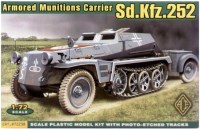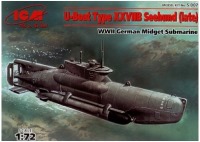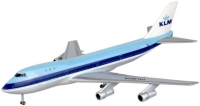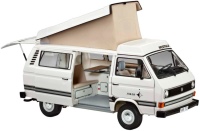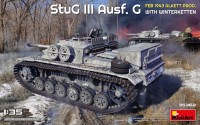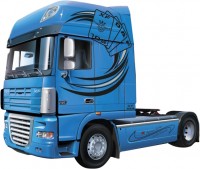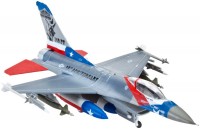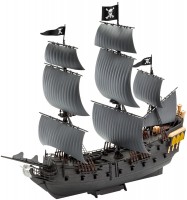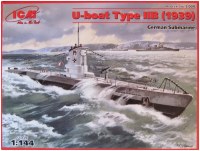Model Building Kits Zvezda
All models Advanced filters → |
You might be interested in
Model Building Kits: specifications, types
Age
The minimum user age for which the model is designed.
This parameter is specified taking into account the complexity of the model and the skills required to assemble it. Note that in this case, the age category is a very conditional indicator: if the child shows a talent for design and you are confident in his skills, you can give the young modeler a set of the age category “a year older” without waiting for the calendar birthday. However, if there is no such confidence, deviating from age recommendations is highly discouraged. Too "adult" and complex set can not only discourage a child from any desire for modeling, but also be dangerous to health: the glue and paints included in the set require strict adherence to safety rules, with which young children often have problems.
Models with the following minimum age recommendations are now on the market: 6+, 7+, 8+, 10+, 11+, 12+, 13+, 14+, 15+.
This parameter is specified taking into account the complexity of the model and the skills required to assemble it. Note that in this case, the age category is a very conditional indicator: if the child shows a talent for design and you are confident in his skills, you can give the young modeler a set of the age category “a year older” without waiting for the calendar birthday. However, if there is no such confidence, deviating from age recommendations is highly discouraged. Too "adult" and complex set can not only discourage a child from any desire for modeling, but also be dangerous to health: the glue and paints included in the set require strict adherence to safety rules, with which young children often have problems.
Models with the following minimum age recommendations are now on the market: 6+, 7+, 8+, 10+, 11+, 12+, 13+, 14+, 15+.
Scale
The scale describes how many times the assembled model is smaller than the original from which it was copied: for example, the designation 1:35 means that the copy is 35 times smaller. Accordingly, the larger the number in the denominator, the smaller the scale, the smaller the individual details will be.
Manufacturers choose a specific scale, taking into account the characteristics of a particular model, primarily its type (see the relevant paragraph). For example, passenger cars may well be performed on a large scale like 1:24 or even 1:16; but the ships usually have a scale no larger than 1:72 – otherwise the assembled models would be too bulky.
Note that although there are many different scales on the market ( 1:32, 1:35, 1:48 – 1:70, 1:72, 1:75 – 1:142, 1:144, 1:146), "classic genre” for many modellers are considered 1:72 and 1:144; in particular, many models of military equipment are produced on such a scale.
Manufacturers choose a specific scale, taking into account the characteristics of a particular model, primarily its type (see the relevant paragraph). For example, passenger cars may well be performed on a large scale like 1:24 or even 1:16; but the ships usually have a scale no larger than 1:72 – otherwise the assembled models would be too bulky.
Note that although there are many different scales on the market ( 1:32, 1:35, 1:48 – 1:70, 1:72, 1:75 – 1:142, 1:144, 1:146), "classic genre” for many modellers are considered 1:72 and 1:144; in particular, many models of military equipment are produced on such a scale.
Model type
The general type of a model is the object it copies.
— Cars. Various cars, mostly cars, although there are other varieties — minivans, SUVs, trucks. A separate category is retro cars.
— Airplanes. Civil aviation aircraft — from light "corn" to long-haul passenger liners. Military aircraft in our catalog are allocated in a separate category (see the relevant paragraph).
— Helicopters. Helicopters of civil aviation, as well as various special services — medical, police, search and rescue, etc. (except for military helicopters, they are in a separate category — see the relevant paragraph).
— Ships. This category includes civil ships in the broadest sense of the word: passenger, fishing, scientific, search and rescue, etc. Warships in our catalog belong to the category of "naval equipment" (see the relevant paragraph), also in their own category sailing ships are highlighted.
— Sailing ships. Ships of the sailing fleet — from longships and junks to huge galleons and clippers.
— Military ground equipment. Various ground military equipment, not related to tanks, armored personnel carriers and ot...her specialized varieties. This category includes, in particular, military all-terrain vehicles, rocket systems like Katyusha / Grad, etc.
— Tanks, self-propelled guns. Tanks and self-propelled artillery mounts are caterpillar armored vehicles with large-caliber guns.
— BTR, BMP. Various lightly armored vehicles: armored personnel carriers, infantry fighting vehicles, armored vehicles. Most armored personnel carriers are wheeled, but tracked vehicles also come across. BMP — a cross between an armored personnel carrier and a light tank, a tracked vehicle with powerful weapons and a compartment for infantry. Armored vehicles — armored wheeled vehicles for transporting and/or fire support for infantry; it can be both historical armored cars and modern army off-road vehicles.
— Military trucks and tractors. Military trucks and tractors are equipment that does not take a direct part in battles and is designed to transport various cargoes, towed artillery, etc.
— Military aircraft. Most models of military aircraft are copied by fighters, although there are other classes — bombers, transports, etc.
— Military helicopters. Various combat helicopters — both directly assault / attack, and transport, multi-purpose, etc.
— Naval equipment. This category mainly includes warships, although other equipment can also be found — amphibious landing ships, ferries and pontoons for guiding crossings, etc. Note that submarines are placed in a separate category (see the relevant paragraph).
— Submarines. Modern models of submarines can be either closed, "in natural form", or open — with openings in the sides, allowing you to see the internal structure of the ship.
— Fantasy. Models of various fantastic machines and mechanisms — starships, robots, futuristic tanks and planes, etc.
— Cars. Various cars, mostly cars, although there are other varieties — minivans, SUVs, trucks. A separate category is retro cars.
— Airplanes. Civil aviation aircraft — from light "corn" to long-haul passenger liners. Military aircraft in our catalog are allocated in a separate category (see the relevant paragraph).
— Helicopters. Helicopters of civil aviation, as well as various special services — medical, police, search and rescue, etc. (except for military helicopters, they are in a separate category — see the relevant paragraph).
— Ships. This category includes civil ships in the broadest sense of the word: passenger, fishing, scientific, search and rescue, etc. Warships in our catalog belong to the category of "naval equipment" (see the relevant paragraph), also in their own category sailing ships are highlighted.
— Sailing ships. Ships of the sailing fleet — from longships and junks to huge galleons and clippers.
— Military ground equipment. Various ground military equipment, not related to tanks, armored personnel carriers and ot...her specialized varieties. This category includes, in particular, military all-terrain vehicles, rocket systems like Katyusha / Grad, etc.
— Tanks, self-propelled guns. Tanks and self-propelled artillery mounts are caterpillar armored vehicles with large-caliber guns.
— BTR, BMP. Various lightly armored vehicles: armored personnel carriers, infantry fighting vehicles, armored vehicles. Most armored personnel carriers are wheeled, but tracked vehicles also come across. BMP — a cross between an armored personnel carrier and a light tank, a tracked vehicle with powerful weapons and a compartment for infantry. Armored vehicles — armored wheeled vehicles for transporting and/or fire support for infantry; it can be both historical armored cars and modern army off-road vehicles.
— Military trucks and tractors. Military trucks and tractors are equipment that does not take a direct part in battles and is designed to transport various cargoes, towed artillery, etc.
— Military aircraft. Most models of military aircraft are copied by fighters, although there are other classes — bombers, transports, etc.
— Military helicopters. Various combat helicopters — both directly assault / attack, and transport, multi-purpose, etc.
— Naval equipment. This category mainly includes warships, although other equipment can also be found — amphibious landing ships, ferries and pontoons for guiding crossings, etc. Note that submarines are placed in a separate category (see the relevant paragraph).
— Submarines. Modern models of submarines can be either closed, "in natural form", or open — with openings in the sides, allowing you to see the internal structure of the ship.
— Fantasy. Models of various fantastic machines and mechanisms — starships, robots, futuristic tanks and planes, etc.
Belonging to the army (or country)
"National affiliation" of the model — more precisely, the real technology from which this model is copied. For example, if the kit is intended for assembling an American fighter, this item will indicate "USA" (regardless of the country in which the kit was actually released).
This option will be useful primarily for those who are looking for copies of equipment from certain countries. Nowadays, the market is mainly represented by models with the following affiliation options (in alphabetical order): Brazil, Great Britain, Germany, Spain, Italy, Canada, Netherlands, Norway, Russia, USSR, USA, France, Sweden, Japan.
This option will be useful primarily for those who are looking for copies of equipment from certain countries. Nowadays, the market is mainly represented by models with the following affiliation options (in alphabetical order): Brazil, Great Britain, Germany, Spain, Italy, Canada, Netherlands, Norway, Russia, USSR, USA, France, Sweden, Japan.
Epoch
The period of time to which this model is devoted. A fairly obvious parameter; we only note that most of the models associated with world wars copy military equipment, it is better to look for civilian equipment in other periods.
Now on the market there are models of such eras: the fleet of the XV-XVIII centuries, the first world war, the second world war, the 50-90s of the twentieth century, modern technology.
Now on the market there are models of such eras: the fleet of the XV-XVIII centuries, the first world war, the second world war, the 50-90s of the twentieth century, modern technology.
Number of details
The total number of parts provided in the kit.
The larger this number, with the same scale and type of model, the more qualitative and detailed, usually, the model is. On the other hand, with an increase in the number of parts, the complexity of assembly also increases, especially with a small scale and, accordingly, a miniature size of individual elements. Accordingly, for beginner modellers it is desirable to choose kits with a small number of parts, and as skills improve, you can pay attention to more advanced kits.
Nowadays, kits with less than 100 parts are considered relatively simple, from 100 to 250 parts are considered intermediate, 250-500 parts correspond to the advanced level, and the most extensive sets include more than 500 elements.
The larger this number, with the same scale and type of model, the more qualitative and detailed, usually, the model is. On the other hand, with an increase in the number of parts, the complexity of assembly also increases, especially with a small scale and, accordingly, a miniature size of individual elements. Accordingly, for beginner modellers it is desirable to choose kits with a small number of parts, and as skills improve, you can pay attention to more advanced kits.
Nowadays, kits with less than 100 parts are considered relatively simple, from 100 to 250 parts are considered intermediate, 250-500 parts correspond to the advanced level, and the most extensive sets include more than 500 elements.
Figures of people
The number of people figurines provided in the set.
Figures of people give the assembled model additional realism. At the same time, the delivery set often includes not only the crew of the equipment, but also other "characters"; such a set may be intended for assembling a plot scene — for example, the calculation of guns in position, a group of soldiers unloading a vehicle, etc.
Figures of people give the assembled model additional realism. At the same time, the delivery set often includes not only the crew of the equipment, but also other "characters"; such a set may be intended for assembling a plot scene — for example, the calculation of guns in position, a group of soldiers unloading a vehicle, etc.
Material
The material from which the model is made.
— Plastic. A material that is considered a classic for prefabricated models. Plastic is inexpensive and easy to manufacture, quickly and reliably sticks together, paint adheres well to it. In addition, parts made of this material can be easily reworked if necessary — for example, if you need to fix a factory defect or if the modeller wants to make some changes to the original design. As a result, the vast majority of modern models are made of plastic.
— Tree. The material used mainly in replicas of a sailing fleet — wood gives the model the maximum resemblance to a real ship. But for other types of models, it is more justified to use plastic, so wood is almost never found in them.
— Plastic. A material that is considered a classic for prefabricated models. Plastic is inexpensive and easy to manufacture, quickly and reliably sticks together, paint adheres well to it. In addition, parts made of this material can be easily reworked if necessary — for example, if you need to fix a factory defect or if the modeller wants to make some changes to the original design. As a result, the vast majority of modern models are made of plastic.
— Tree. The material used mainly in replicas of a sailing fleet — wood gives the model the maximum resemblance to a real ship. But for other types of models, it is more justified to use plastic, so wood is almost never found in them.



